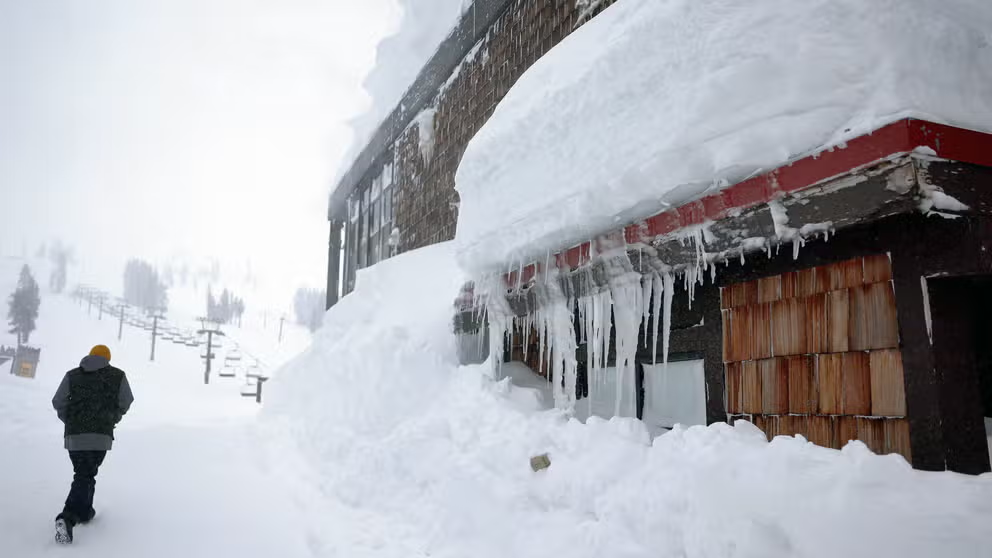California undergoes 'Miracle March' in recovering snowpack deficit with recent dayslong blizzard
The 10-plus feet of snow from the past weekend's blizzard pushed snow pack levels to normal levels after a very slow start to the snow season. California gets 30% of its water from the Sierra snowpack melt.
Recent blizzard pushes California mountains to normal snowpack levels
After 10 feet of snow fell across the Sierra Nevada in California after the weekend blizzard, ski resorts and water managers alike are celebrating as snowpack totals are at normal levels after a slow winter snow season.
Ski resorts are calling the current month "Miracle March" after a blizzard dumped up to 10 feet of snow on California's Sierra Nevada Mountains, and they are not alone. State water managers are celebrating too.
The snow water equivalent started the year at a slim 28% of average. February's start was better, but still only 53% of average. Today, the percentage sits above normal at 104%.
PHOTOS: MONSTER CALIFORNIA BLIZZARD LEAVES EPIC SCENES OF TOWNS BURIED IN FEET OF SNOW
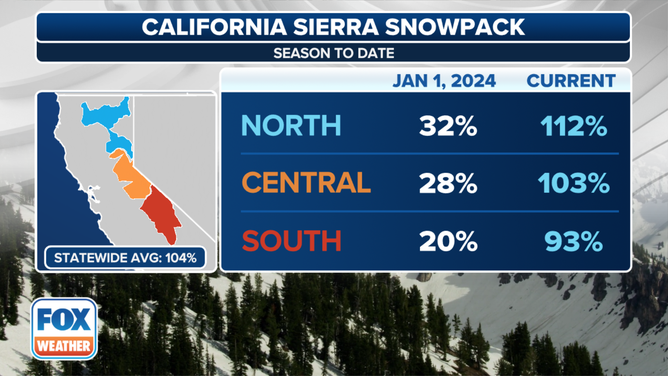
The statewide average on Jan. 1 was only 28%. Today the state average is 104%.
(FOX Weather)
Why do water managers measure snow?
The snow water equivalent is the actual measure of how much water is locked up in the snow that can refill reservoirs and aquifers in the spring melt. Melting the snowpack on the ground would net that amount of water in inches. So, as of Jan. 1 there were less than 3 inches of water locked in snow. Feb. 1 saw under 9 inches of water and now March 5, levels are up to over 20 inches of water.
"Psst... you want some great news? The storm helped out the whole state A LOT!" posted the UC Berkeley Central Sierra Snow Lab on social media. "We're also at 94% of our April 1st normal and should be able to get to 100%."
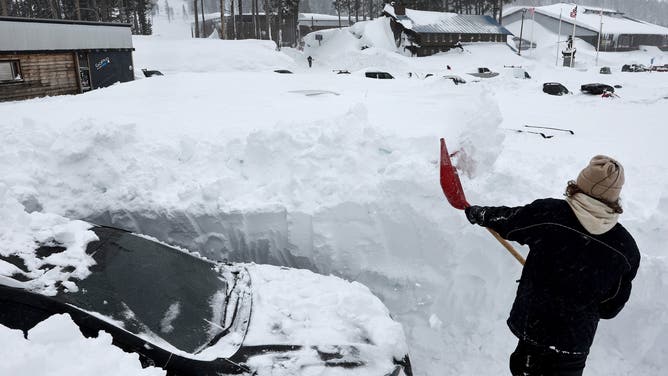
SODA SPRINGS, CALIFORNIA - MARCH 04: Caden Drefs helps dig a friend's car out at Boreal Mountain Resort, currently shuttered due to the storm, following a massive snowstorm in the Sierra Nevada mountains on March 04, 2024 in Soda Springs, California.
(Mario Tama / Getty Images)
April 1 is traditionally the peak depth of the snowpack. After that, the snow usually starts melting.
A ‘normal’ snowpack year should go a long way in keeping California out of drought. The Sierra snowpack alone supplies 30% of the Golden State's water, including drinking and irrigation water. Currently, no part of the state is under drought. About 7% of the state is still abnormally dry. One year ago, almost half the state was suffering drought conditions.
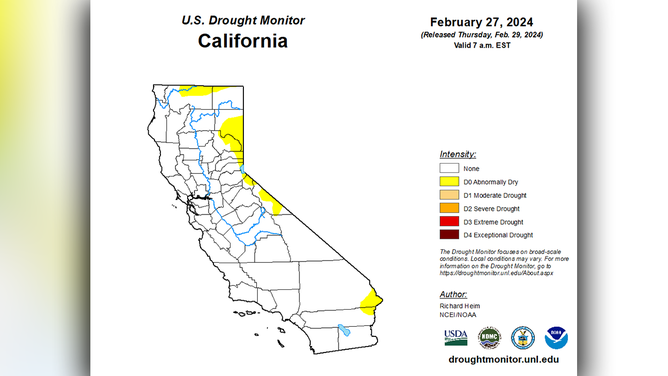
The current California Drought Monitor shows no part of the state in drought. The yellow areas indicate "abnormally dry."
(US Drought Monitor / NOAA)
"Lack of snow can ultimately impact how much runoff continues to help fill our reservoirs, especially during the spring and summer months when water supply demand is at its highest," explained California State Hydro-meteorologist, Angelique Fabbiani-Leon.
After a dry fall, mountain snow got off to a slow start this winter, according to the California Department of Water Resources.
"The first survey here, two months ago, we saw the tufts, the grass sticking out through the snow, and the ground was barely covered," said Andy Reising, California Department of Water Resources Engineer, at a press conference. "We have had a number of warmer storms come in, and the snow-rain line was a lot higher then. And so what that means is, where we're normally hoping to build snowpack, rain was falling instead. We didn't get the lower snow like we'd like."
Scenes from California's Sierra Nevada where 6-10 feet of snow fell amid dayslong blizzard
Photos show the aftermath of a blizzard that dumped as much as 10 feet of snow across the Sierra Nevada over the weekend leaving residents to begin digging out.
And while last winter's rain and snow erased a three-year drought, water managers said they are thankful to not have a repeat this season.
"Our snowpack has been at an ideal pace that we'd like to see. They've (storms) been spread out enough to allow relief for our river systems," said Fabbiani-Leon. "This is quite different than last year, where we received several atmospheric rivers back to back, which ultimately caused flooding impacts across the state."
RIDICULOUS PHOTOS SHOW AFTERMATH OF 12 FEET OF SNOW IN CALIFORNIA'S SIERRA NEVADA

File: Neil Lareau shows the view from the kitchen sink in Truckee, California, on Monday, Feb. 27, 2023.
(@nplareau / Twitter / FOX Weather)
Miracle March for skiers
Back to the ski resorts with this Miracle March: A very happy Patrick Lacey of the Palisades Tahoe Resort joined FOX Weather Tuesday morning to talk about the boon of snow for skiers.
"I was skiing yesterday and it was absolutely fabulous, just this nice powdery, buttery. It doesn't get much better than that," Lacey said. "I mean, eight feet of snow in four days. I haven't seen it, like that up here in a long, long time."
He said the resort got so much snow, crews had to truck it out to make room for parking.
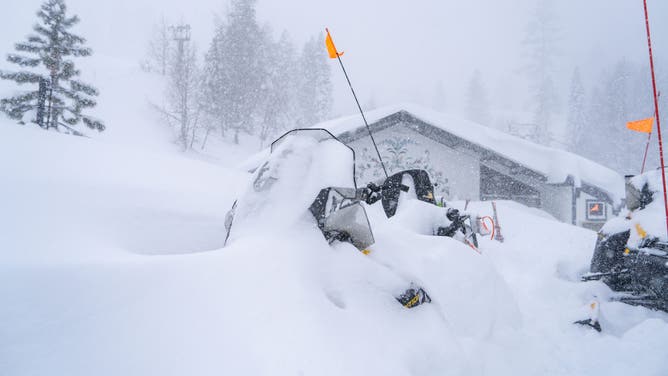
Palisades Tahoe has a big job ahead cleaning out from the blizzard.
(Blake Kessler/Palisades Tahoe / FOX Weather)
The March snow extends the ski season at Palisades Tahoe to Memorial Day.
"It's going to be absolutely incredible," Lacey said.
The term "Miracle March" was actually coined in 1991 when the snowpack went from 17% of average to 73% of average in 29 days, according to the Tahoe Fund. The repeat came in 2018 when snowpack went from 32% of average to 77%.

